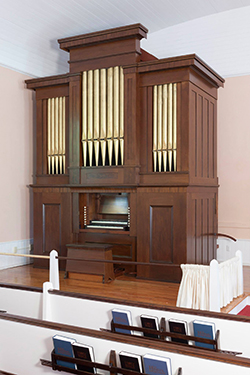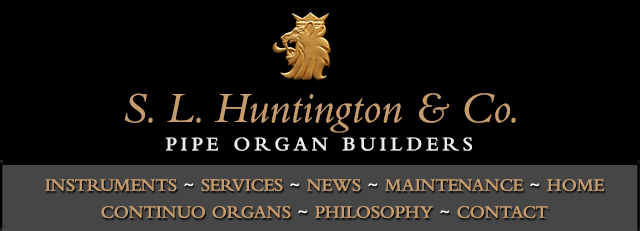
Wm. A. Johnson’s restored Opus 16
| I. |
Great 54 notes, unenclosed |
| 1. |
Op. Diapason |
8′ |
| 2. |
St. Diapason Treble (new) |
8′ |
| 3. |
Dulciana |
8′ |
| 4. |
St. Diapason Bass |
8′ |
| 5. |
Principal |
4′ |
| 6. |
Flute |
4′ |
| 7. |
Twelfth |
2⅔′ |
| 8. |
Fifteenth |
2′ |
| |
| II. |
Swell 37 notes, enclosed |
| 9. |
Op. Diapason |
8′ |
| 10. |
St. Diapason |
8′ |
| 11. |
Principal |
4′ |
| 12. |
Hautboy |
8′ |
| 13. |
St. Diap. Bass* |
8′ |
| |
| III. |
Pedal 17 notes, unenclosed |
| 14. |
Dou. Op. Diapason** |
16′ |
| |
| IV. |
Couplers |
| 15. |
Couple Gt. & Sw. |
| 16. |
Pedal Coupler (Great) |
Swell expression by hitch-down
toe-lever
Hand-pumping feeders and mechanisms restored to use
* later addition by Wm. Johnson
** G-compass Open Diapason pipes converted in 1850 to a C-compass Bourdon |
ASSOCIATED PRESS ARTICLE
"Historic pipe organ back in Heath church."
 |
 |
Heath Union Church
Heath, Massachusetts
 |
This organ received
OHS Citation number 376. |
Heath is the third home of this landmark pipe organ, the oldest surviving instrument built by one of New England’s foremost organbuilders, William A. Johnson of Westfield, Massachusetts. Only the second two-manual instrument attempted by the then-fledgling builder, Opus 16 was begun on speculation in 1849, to a G-compass design, and purchased unfinished by Joel Hayden, Sr. for the Haydenville Congregational Church, then also under construction. Hayden was founder of the town bearing his name, owner of the large brass works established there, and later Lieutenant Governor of Massachusetts. The organ was modified considerably prior to its late-1850 installation in the unfinished church, including conversion to C-compass. It was pumped from 1850-1854 by a youth named Cyrus Burnett Smith, whose numerous signatures were pivotal in the process of dating and solving puzzling questions associated with the organ’s early history. His later life as a noted surgeon in the Civil War is a story unto itself.
Opus 16 was replaced in 1874 by a larger Johnson instrument purchased to memorialize the recently deceased Hayden; and, the church narrowly escaped the infamous April 1874 flooding of the Mill River which brought unprecedented devastation along its path from Williamsburg to Florence. The organ was moved then to the nearby Congregational Church of Whately, fitted with a new case to the taste of the day. In 1914, the Whately Church replaced the Johnson with a smaller but more modern Estey organ, provided with grant assistance from the Andrew Carnegie Foundation. The Johnson organ was relocated to Heath, where it was installed without further alteration, nor even much maintenance, save for the later addition of an electric blower. Nearly one hundred years later, age and fatigue had taken their toll on this venerable instrument; and for more than a decade, the Heath congregation worked to raise the funds, with strong support from surrounding communities, for a full and proper restoration of this organ, now recognized as a pivotal milestone in American organ building.
In March 2013, the Stonington, Connecticut firm of S. L. Huntington & Co. completed a thorough renovation of this notable instrument. The restoration has followed strictly the newly revised OHS Guidelines for Conservation, carefully analyzing details of the organ’s history and construction, recreating the original casework and faux-grain decoration, including the reinstatement of the 1850 gilded façade pipes (found still in use but well hidden inside the 1874 case), and replication of a missing rank of Stopped Diapason pipes. The painstaking, even microscopic efforts of Scot Huntington and his collaborators (including Marylou Davis of Woodstock, Conn., the country’s leading expert on antique pipe organ decoration) to understand the mechanical design and construction, the history, and the musical sounds before them, has led to an exemplary restoration project of worthy acclaim. |
| |
|
|

DEDICATION RECITAL
 On July 21, 2013 at 4:00pm, Nathan Laube dedicated the newly completed restoration of William A. Johnson Opus 16, 1850, at the Union Evangelical Church, 5 East Main Street, Heath, Massachusetts. This is the oldest extant organ by the famous Johnson firm, and has been meticulously restored to original condition following the revised O.H.S. Guidelines for Conservation and Preservation, including the reconstruction of the original facade and casework. On July 21, 2013 at 4:00pm, Nathan Laube dedicated the newly completed restoration of William A. Johnson Opus 16, 1850, at the Union Evangelical Church, 5 East Main Street, Heath, Massachusetts. This is the oldest extant organ by the famous Johnson firm, and has been meticulously restored to original condition following the revised O.H.S. Guidelines for Conservation and Preservation, including the reconstruction of the original facade and casework.

Download a PDF
of the Recital Program
|
|

Dear Scot,
Absolutely everything I love about this field of Historic pipe organs came together inspirationally yesterday at the dedication of the Johnson Opus 16. And if weren't for YOU (and Bill as initiator) - it wouldn't have happened at all. Your unparalleled effort and ability in thorough research, your management of the project as a whole, your ability in communication, collaboration - your artistic skill including writing and speaking not to mention many, many other abilities were superbly displayed at the highest level in yesterday's dedication and performance. It was simply magnificent.
I watched a community bask in the most glorious organ music they've probably ever heard or will hear and in their own church! and on their own antique organ now fully restored. And they had the extreme pleasure of knowing they were the patrons of something that is so far beyond anything they've witnessed or heard before.
Your contribution with Opus 16 exemplifies the importance of highest achievable restoration and conservation so now stands as a 3D model in that for the field. Your gracious enthusiasm in speaking, your zest for leaving no stone unturned, your work in bringing many hands and voices to the work - are all something I've never seen anyone else pull off so well, so broadly, or single-handedly.
Congratulations! And thank you for including me in part of the process. The joy I derived from yesterday's concert was like none I've ever had before. The profound pleasure of hearing Nathan Laube play this instrument was an experience that can't be duplicated. I am so very grateful to you in the most personal of feeling and manner.
Sincerely,
Marylou Davis
Marylou Davis specializes in historic period design and the conservation and replication of historic decorative finishes. |
|



